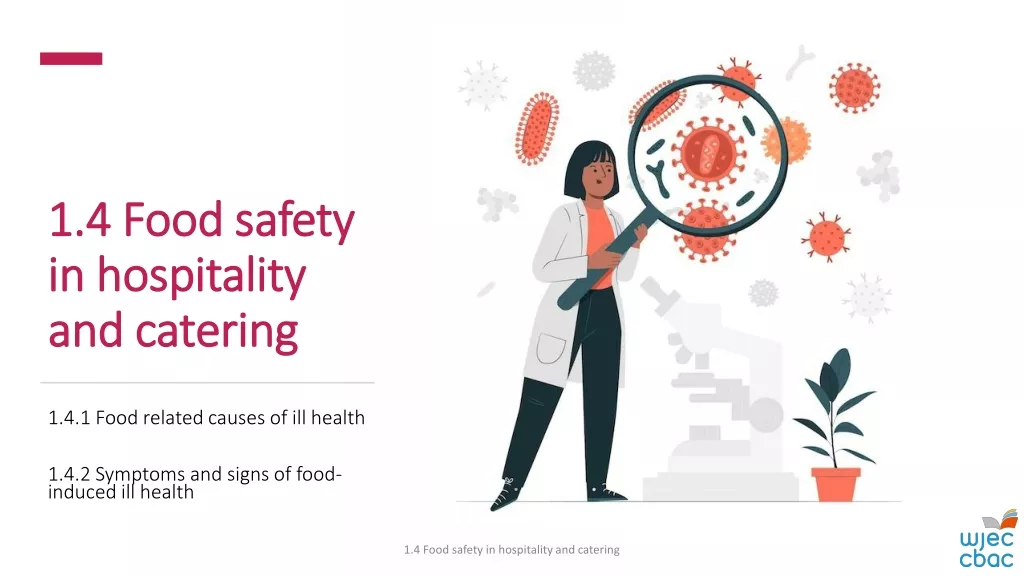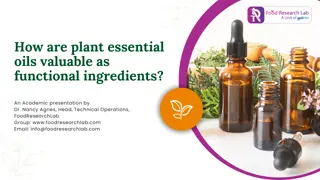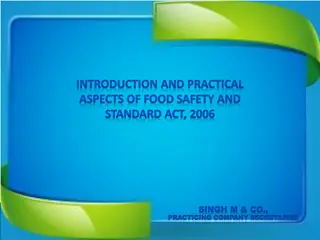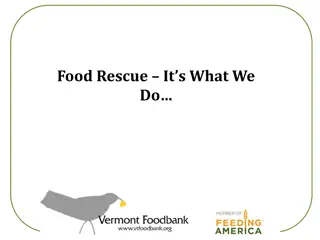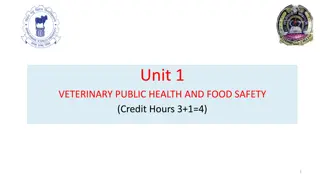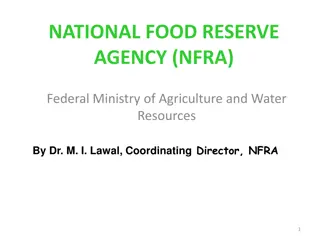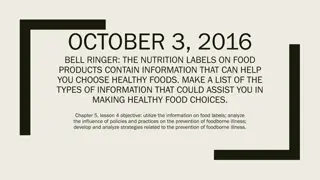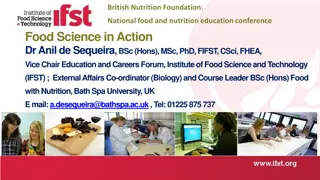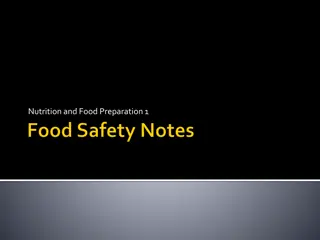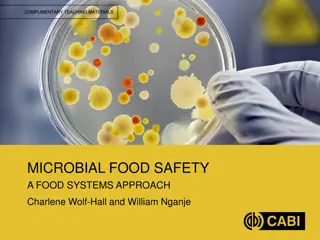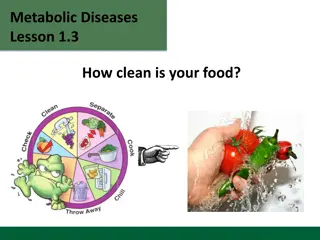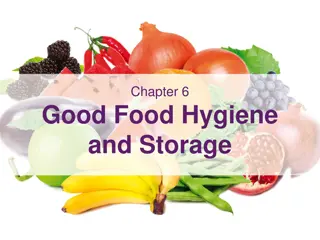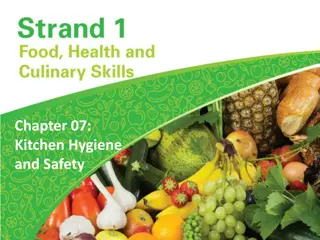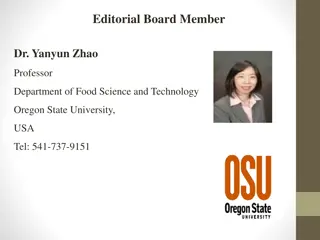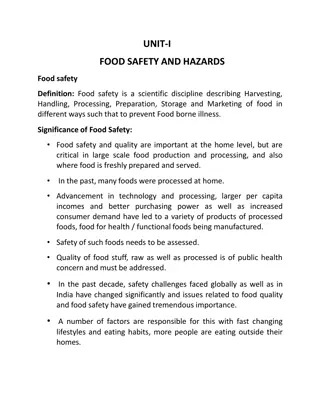Food Safety Challenges in a Changing World
Eating food poses risks, and maintaining food safety is crucial. Factors like changing habits, processing methods, and global trade impact food safety. Diseases like acute diarrhoea are a global concern, emphasizing the need for vigilance. Ecosystem changes also contribute to food safety challenges, such as the rise of pests, water contamination, and marine biotoxins. Ensuring safe food production and consumption is essential amidst these evolving threats.
Download Presentation

Please find below an Image/Link to download the presentation.
The content on the website is provided AS IS for your information and personal use only. It may not be sold, licensed, or shared on other websites without obtaining consent from the author. Download presentation by click this link. If you encounter any issues during the download, it is possible that the publisher has removed the file from their server.
E N D
Presentation Transcript
Dr. N. N. Zade Director of Extension Education and Trainings, Maharashtra Animal & Fishery Sciences University, Nagpur
"Food" means a raw, cooked, or processed edible substance, ice, beverage, or ingredient used or intended for use or for sale in whole or in part for human consumption, or chewing gum. (Food and Drug Administration 1999 Food Code)
Eating food is a risky process Innate Immunity and traditional culinary practices are major protective factors
A suitable product which when consumed orally either by a human or an animal does not cause health risk to consumer. OR Assurance that food will not cause harm to the consumer when it is prepared and/ or eaten according to its intended use.
Changing food habits Increased processing and handling Changing processes, products Globalization of food trade
Acute diarrhoeal illness is very common worldwide and estimated to account for 1.8 million childhood deaths annually, predominantly in developing countries (World Health Organization, 2005)
CDC, USA
Eco system changes lead to more pests, less predators, more vectors for microbes Unseasonal rains humidity and fungal growth Flooding water contamination- soil contamination- unsafe food Higher Ocean temperatures- algal blooms- harbour Vibrios in spore like forms- Novel strains' eg O139 Bengal Changes in aquatic life and formation of marine biotoxins in sea foods due to production of phytotoxins by harmful algae
residues Drug
India is the world's second largest producer of food next to China India is one of the worlds major food producers but accounts for less than 1.5 per cent of international food trade. This indicates vast scope for both investors and exporters. Food exports in 1998 stood at US $5.8 billion whereas the world total was US $438 billion.
The Indian food industries sales turnover is Rs 140,000 crore (1 crore = 10 million) annually as at the start of year 2000. The industry has the highest number of plants approved by the US Food and Drug Administration (FDA) outside the USA.
Multiple food laws Varied quality/safety standards Rigid and non responsive standards Poor information dissemination to consumers
Nine different laws and eight different ministries governing the food sector Laws framed by different Ministries/Depts. With different perspective and enforcement approach Overlapping laws with different quality standards & labelling requirements
The Prevention of Food Adulteration Act, 1954 Fruits and Vegetable Products (Control) Order- FPO 1955" Meat Food Products Order (MFPO)1973 Vegetable Oil Products (Control) Order, 1947 Edible Oils Packaging (Regulation) Order, 1988, Solvent Extracted Oil, De-oiled Meal and Edible Flour (Control) Order, 1967 Milk and Milk Products Order, 1992
F S S A The PFA Act, 1954 EOP Order 1988 Solvent Extracted Oil, De-oiled Meal and Edible Flour (Control) Order, 1967 MMPO 1992 FPO 1995 MFPO 1973 VOP Order 1947 FOOD SAFETY AND STANDARD ACT 2006
Food Safety and Standards Act ,2006 - passed by Indian Parliament and notified on 24th August, 2006 Authority Established- in Sept, 2008 FSS Regulations Notified -3rd August, 2011 New Act operationalised- 5th August,2011 All Food Business Operators in India to get Licensed/Registered with Food Safety Authority
The Act covers activities throughout the food distribution chain, from primary production through distribution to retail and catering. The Act gives the Government powers to make regulations on matters of food safety. The Food Safety & Standards Authority of India is the principal Government Authority responsible for preparing specific regulations under the Act.
Research institutes/ laboratories Regulators Industry Food Safety Govt. Agencies Farmers organizations Consumer organizations
To consolidate multiple laws and establish single point reference system 1 To establish Food Safety and Standards Authority 2 To regulate the manufacture, storage, distribution, sale and import of food products 3 To ensure availability of safe and wholesome food for human consumption 4
Laboratories in public and private sectors involved Full time officers Monitoring and surveillance Safety Single authority
Multilevel, multi dept. control to single line of command Single reference point Integrated response Decentralization of licensing High degree of consumer confidence Transparent regulatory mechanism
Investor friendly mechanism Adequate information dissemination Speedy disposal of cases Consistency between domestic and international food laws
Involvement of stake holders in decision making The apex body has wider representation of food technologists, scientists, State Govt., farmers, Retailers, Consumer organizations, food industry Science based standards Science based Standards that distinguish substandard and unsafe food Risk Assessment and Management integral to standards setting and enforcement
Improved regulatory structure New enforcement structure Multi level, multi departmental control shift to a single line of control Large network of laboratories Regulation of food imported in the country
Improved monitoring system Active and Passive Surveillance Annual Audit Good food traceability and recall plan
Improved justice delivery Different procedure to deal with Civil and criminal penalties Provision for Adjudication and fast track disposal of cases Constitution of Tribunals
Promotion of innovations Provisions for Functional and Novel Foods , dietary supplements, nutraceuticals etc.) Consumer empowerment Safeguard consumers expectations of substance, quality in a non misleading presentation Consumers can take samples and get it analysed
Accountability Provision for penalty against officer (Upto 1 lakh) In all cases prior notice to FBO Private public participation in enforcement Accreditation of Private agencies/individuals for audit/inspections Accreditation of private Laboratories
CEO, FSSAI Central licensing authority Commissioner of food safety states FSSAI headquarter monitoring Registration authority Licensing authority Zonal Director and other officers Designated officer Municipal corporation Licensing authority Nagar Nigam Gram panchayat Food safety officer
Registration required for the Food Business Operator, who is a manufactures or sells any article of food himself or a petty retailer, hawker, itinerant vendor or temporary stall holder; or such food business including small scale or cottage or tiny food businesses with an annual turnover not exceeding Rs 12 lakhs and or whose- Production capacity of food (other than milk and milk products and meat and meat products) does not exceed 100 kg/ltr per day or Production or procurement or collection of milk is up to 100 litres of milk per day or Slaughtering capacity is 2 large animals or 10 small animals or 50 poultry birds per day or less than that
Central License required for the Food Business Operator, who: Dairy units including milk chilling units process more than 50 thousand litres of liquid milk/day or 2500 MT of milk solid per annum. Vegetable oil processing units having installed capacity more than 2 MT per day. All slaughter houses equipped to slaughter more than 50 large animals or 150 or more small animals or 1000 or more poultry birds per day Meat processing units equipped to handle or process more than 500 kg of meat per day or 150 MT per annum All food processing units other than mentioned above having installed capacity more than 2 MT/day.
100 % Export Oriented Units All Importers importing food items for commercial use. All Food Business Operators manufacturing any article of Food which does not fall under any of the food categories prescribed under these regulations or deviates in any way from the prescribed specification for additives therein. Retail chains operating in three or more states. Food catering services in establishments and units under Central government Agencies like Railways, Air and airport, Seaport, Defence etc.
Volume State licensing Medium scale Food Business Operators Central Licensing State licensing Big Scale Small Scale Petty Food Business Operators
HR requirement Laboratory professionals HR Regulators Auditors requirement FBOs
Constitution of Authority, scientific Committee, and 8 Expert Panels Notification of Rules and 6 Regulations Transparency in online registration Accreditation of 61 private labs Accreditation of 12 Food Safety Management System agencies
89 Individual for Inspection/ Auditing Food Imports brought under FSS Act- about 75 % of total food imports in country. Surveillance survey- Milk Sampling of food products and prosecution going on in states Action has been taken against false claims/ advertisements
Setting of Food Safety Standards Risk based Assessment Effective Food Born Disease Surveillance System Traceability, Recall and Emergency response system Inform, Educate and Communicate to the consumers Food Safety Management Systems Capacity Building Research and Development
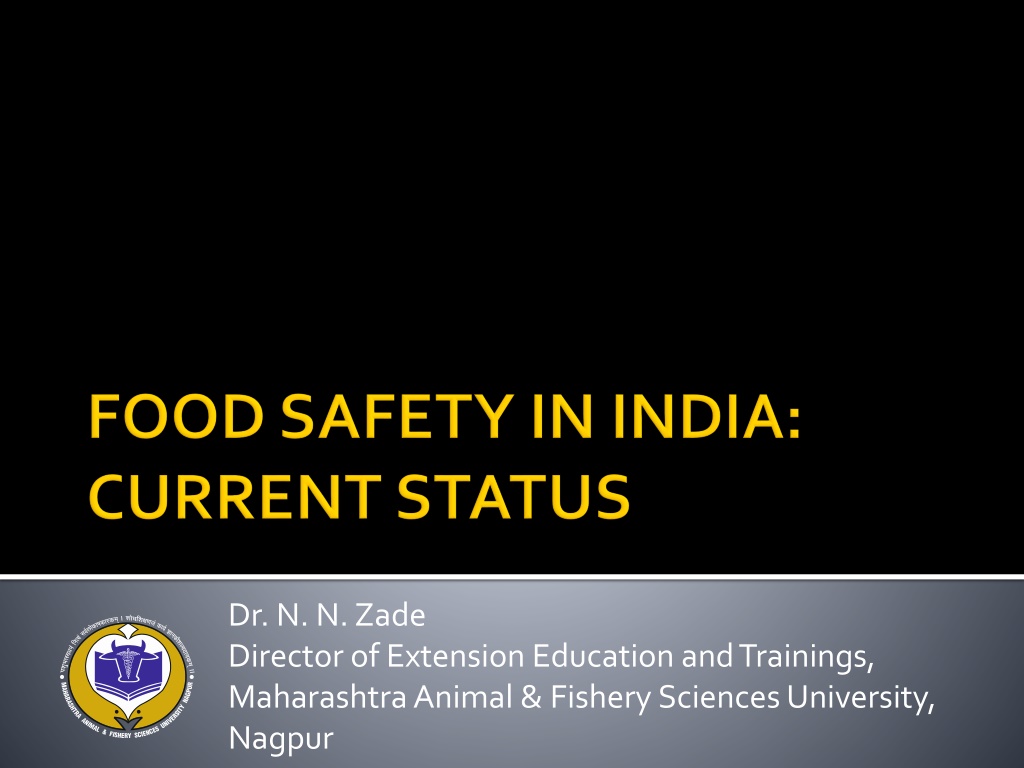
 undefined
undefined










